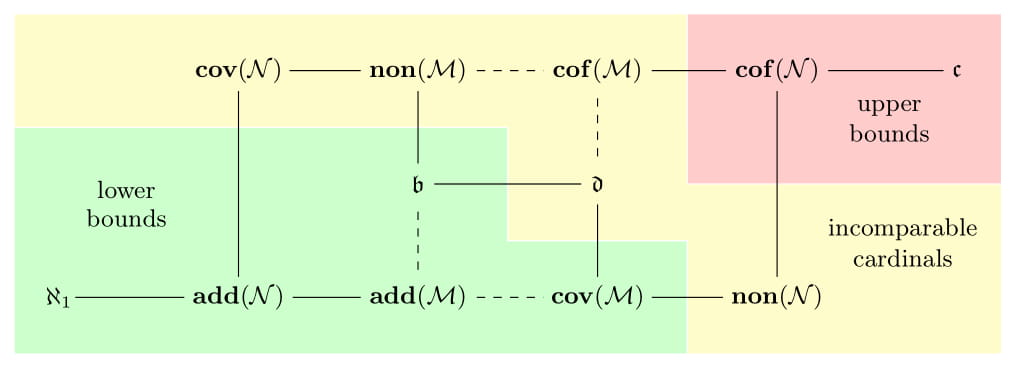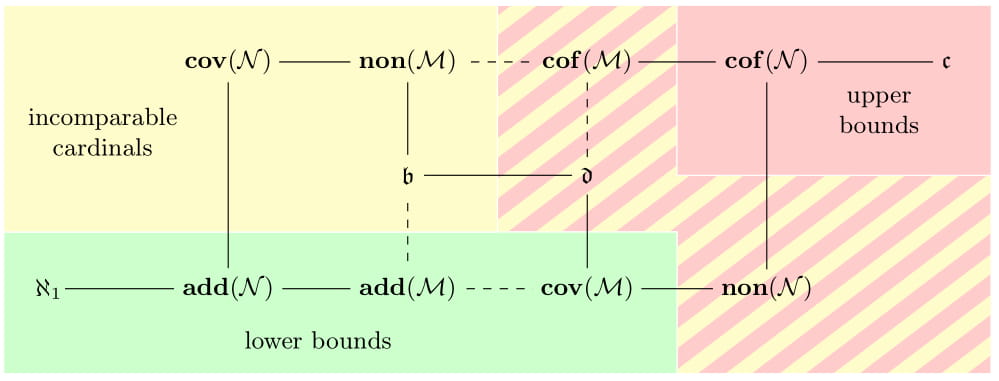First of all, let me say that I love this question.
Alan Dow and I have been thinking about this question and its relatives quite a lot recently. We completed a paper on the topic last week (available on arXiv), and I'll summarize the results here.
As you mention in the comments, the number $\mathfrak{z}$ does not seem to admit a simple combinatorial description, and can be very difficult to work with. Our paper introduces a new cardinal characteristic of the continuum that is closely related to $\mathfrak{z}$ and is "almost" an upper bound for it (in a sense I'll explain below). But the new characteristic has a simple description and is much easier to work with. This allows us to analyze $\mathfrak{z}$ indirectly, by working with a more manageable proxy instead.
Definition: If $U$ and $A$ are infinite sets, we say that $U$ splits $A$ if both $A \cap U$ and $A \setminus U$ are infinite. The splitting number of the reals, denoted $\mathfrak{s}(\mathbb R)$, is the smallest possible cardinality of a collection $\mathcal U$ of open subsets of $\mathbb R$ such that every infinite $A \subseteq \mathbb R$ is split by some $U \in \mathcal U$.
The classical splitting number $\mathfrak{s}$ is the smallest possible cardinality of a collection $\mathcal S$ of subsets of $\mathbb N$ such that every infinite subset of $\mathbb N$ is split by some member of $\mathcal S$. The new number $\mathfrak{s}(\mathbb R)$ is just a topological variant of $\mathfrak{s}$, where instead of splitting subsets of $\mathbb N$ with subsets of $\mathbb N$, we're splitting subsets of $\mathbb R$ with open sets.
I should mention that the value of $\mathfrak{s}(\mathbb R)$ does not change if one replaces $\mathbb R$ with any other uncountable Polish space in the above definition.
Theorem: If $\mathfrak{s}(\mathbb R) < \aleph_\omega$, then $\mathfrak{z} \leq \mathfrak{s}(\mathbb R)$.
(Actually we have a slightly stronger theorem: if there is a cardinal $\kappa$ such that $\mathfrak{s}(\mathbb{R}) \leq \kappa = \mathrm{cof}(\kappa^{\aleph_0},\subseteq)$, then $\mathfrak{z} \leq \kappa$. It follows that $\mathfrak{z} \leq \mathfrak{s}(\mathbb R)$ whenever $\mathfrak{s}(\mathbb R) < \aleph_\omega$, as stated above, and more: if $\mathfrak{z} > \mathfrak{s}(\mathbb R)$, then either $\mathfrak{s}(\mathbb R)$ has countable cofinality, or there are inner models containing measurable cardinals.)
After proving this theorem relating $\mathfrak{z}$ and $\mathfrak{s}(\mathbb R)$, we go on to analyze $\mathfrak{s}(\mathbb R)$ in detail. We prove three lower bounds and one upper bound from $\mathsf{ZFC}$:
$\bullet$ $\mathfrak{s},\,\mathrm{cov}(\mathcal M),\,\mathfrak{b} \ \leq \ \mathfrak{s}(\mathbb R)$.
$\bullet$ $\max\{\mathfrak{b},\mathrm{non}(\mathcal N)\} \, \geq \, \mathfrak{s}(\mathbb R)$.
The second bullet point is particularly significant to your question, because it gives an upper bound for $\mathfrak{z}$ also (at least assuming $\mathfrak{s}(\mathbb R) < \aleph_\omega$). In addition to these inequalities, we prove two consistency results via forcing showing that it is possible to have either of
$\bullet$ $\mathfrak{s}(\mathbb R) \,<\, \mathrm{non}(\mathcal N)$
$\bullet$ $\mathfrak{s}(\mathbb R) \,>\, \mathrm{cof}(\mathcal M) = \mathfrak{d}$.
Taken together, these results completely determine the place of $\mathfrak{s}(\mathbb R)$ in Cichoń's diagram:
In this picture, the green cardinals are (consistently strict) lower bounds for $\mathfrak{s}(\mathbb R)$, the red cardinals are (consistently strict) upper bounds, and a carindal $\kappa$ is yellow we know both that both $\kappa < \mathfrak{s}(\mathbb R)$ and $\mathfrak{s}(\mathbb R) < \kappa$ are consistent.
Returning to your question, I am sad to admit that we still do not know whether $\mathfrak{d} < \mathfrak{z}$ is consistent. In our forcing model with $\mathfrak{d} < \mathfrak{s}(\mathbb R)$, we do not know the value of $\mathfrak{z}$, but this model is of course a good candidate for getting $\mathfrak{d} < \mathfrak{z}$. (It is possible though that $\mathfrak{z} < \mathfrak{s}(\mathbb R)$ in this model; we already know that the inequality $\mathfrak{z} < \mathfrak{s}(\mathbb R)$ holds in the Laver model, although a proof isn't available yet -- this result will go into a future paper.) Another good candidate we've thought of is a model obtained by adding $\aleph_1$ random reals to a model of $\mathsf{MA}+\neg \mathsf{CH}$, but once again we are not yet able to compute $\mathfrak{z}$ in such a model. I will note that $\mathfrak{d}$ is not a lower bound for $\mathfrak{z}$, because $$\aleph_1 = \mathfrak{z} = \mathfrak{s}(\mathbb R) = \max\{\mathfrak{b},\mathrm{non}(\mathcal N)\} < \mathfrak{d} = \aleph_2$$ in the Miller model.
In closing I'll include one more image: it's a picture like the one above for $\mathfrak{s}(\mathbb R)$, but showing what we currently know about $\mathfrak{z}$ instead. The cardinals in the striped region are those that we know are consistently $<\! \mathfrak{z}$, but we don't know yet whether they're consistently $>\! \mathfrak{z}$ as well.


